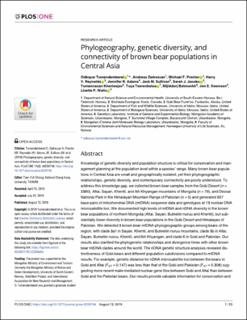| dc.description.abstract | Knowledge of genetic diversity and population structure is critical for conservation and management planning at the population level within a species’ range. Many brown bear populations in Central Asia are small and geographically isolated, yet their phylogeographic relationships, genetic diversity, and contemporary connectivity are poorly understood. To address this knowledge gap, we collected brown bear samples from the Gobi Desert (n = 2360), Altai, Sayan, Khentii, and Ikh Khyangan mountains of Mongolia (n = 79), and Deosai National Park in the Himalayan Mountain Range of Pakistan (n = 5) and generated 927 base pairs of mitochondrial DNA (mtDNA) sequence data and genotypes at 13 nuclear DNA microsatellite loci. We documented high levels of mtDNA and nDNA diversity in the brown bear populations of northern Mongolia (Altai, Sayan, Buteeliin nuruu and Khentii), but substantially lower diversity in brown bear populations in the Gobi Desert and Himalayas of Pakistan. We detected 3 brown bear mtDNA phylogeographic groups among bears of the region, with clade 3a1 in Sayan, Khentii, and Buteeliin nuruu mountains, clade 3b in Altai, Sayan, Buteeliin nuruu, Khentii, and Ikh Khyangan, and clade 6 in Gobi and Pakistan. Our results also clarified the phylogenetic relationships and divergence times with other brown bear mtDNA clades around the world. The nDNA genetic structure analyses revealed distinctiveness of Gobi bears and different population subdivisions compared to mtDNA results. For example, genetic distance for nDNA microsatellite loci between the bears in Gobi and Altai (FST = 0.147) was less than that of the Gobi and Pakistan (FST = 0.308) suggesting more recent male-mediated nuclear gene flow between Gobi and Altai than between Gobi and the Pakistan bears. Our results provide valuable information for conservation and management of bears in this understudied region of Central Asia and highlight the need for special protection and additional research on Gobi brown bears. | en_US |

